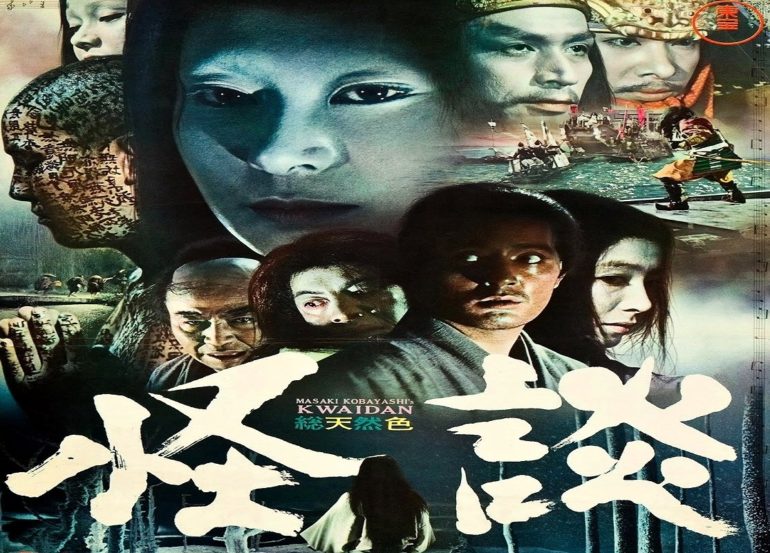Continuing my adventure with the IFI Japanese Story I sat down and watched Kwaidan. Without even realising it, I had picked another horror film. Unlike House, though this film wasn’t as nearly terrifying, Kwaidan is an anthology horror film with four stories within. Each of these stories is based on Japanese folktales with varying results of success. They each felt to me like a kind of Grimm’s Fairytales and were all enjoyable to watch. The main reason being they offered insight into the history of Japan.
Director Masaki Kobayashi weaves the tales within Kwaidan well, each story (save for one) having a concise beginning, middle and end. Even though directed by one person each story in the anthology feels unique and it’s quite impressive.
Stories within a story
The first tale, “Black Hair” is about a samurai and how he leaves the supposed woman he loves so he can live a better life. He marries into a wealthy family but finds no respite, this is mainly due to his new wife who is a spoilt brat who cares nothing for him. It’s a marriage of convenience and throughout the whole story, the samurai laments what he has done. He misses his wife, and constantly dream of seeing her once more. In his dreams, a constant motif is her striking black hair. The story ends in a haunting fashion that is somewhat predictable but this is a film from 1964 based on a Japanese folktale so I easily forgave it.
The next story “The Woman of the Snow” is one of those tales we’ve all heard before. A young woodcutter is stuck in a blizzard and meets a terrifyingly beautiful demonic spirit. She kills his master but having met him she feels pity for him so decides to let him live under one condition. He must never speak of what transpired that night to anyone. So for the rest of this story, I was waiting for this guy to slip. It’s a fascainting and heartbreaking tale that ends on a bitterly tragic note.
“Hoichi the Earless” is easily the best story in my opinion. It takes up the largest chunk of time in this three-hour film and it’s worth the price of admission alone in my opinion. From the set design, cinematography as well as the characters within it, Hoichi the Earless is a fantastic tale. The narrative follows Hoichi, a blind monk who can recite beautifully The Tale of the Heike, a tragic tale about two warring clans that clashes at sea. He recites the tale so well on his biwa that the ghosts of the battle themselves show up to ask him to perform it for them. Unfortunately each night he does it, the performance seems to drain the life out of him. He is eventually found by his fellow monks who try to save him.
Hoichi the Earless is a beautiful part of the Kwaidan epic. There is a particular recurring scene that showcases The Tale of the Heike and this such a remarkable piece of literature put to screen. From the score to the pageantry of the re-enactment this was the film firing on all cylinders.
The final story of Kwaidan is for me the most unnerving. You are welcomed into this story, “In a Cup of Tea” with an explanation by the narrator that not all stories end cleanly. That some tales never get their ending, this could be down to the death of the author, or the publisher and the author falling out. It’s fascinating because throughout In a Cup of Tea I was waiting for that moment. It was a new layer of tension. At what point was this story going to end?
The story follows Sekinai an attendant of a lord who is travelling for the New Year’s Celebration. During a stop-off, he treats himself to some tea while all the other guards are being attentive. When he goes to drink from the cup he sees a mans face smiling back at him. He’s not sure what is happening so he eventually drinks it thinking nothing of it. Unfortunately, when he is guarding his lord the same man appears to him and explains that he has done him harm. It’s deeply unsettling as this man disappears and reappears like some kind of spirit. As this story continues and eventually ends it does leave you with a sense of dread especially with its final shot and I have to say this was a treat to watch.
Director Masaki Kobayashi crafted this tapestry of folktales within Kwaidan wonderfully and even though all of these stories ended in a predictable fashion, they were all enjoyable. Each of them had unique and dazzling set pieces. The cinematography never felt recycled. Each film had its own personality and each personality was highly engaging.
It’s been another great experience with the IFI’s Japanese Story. There is still time to check it out, so get on it. There are so many films to choose from. Hopefully, when I return with the next review I won’t have accidentally chosen another horror film, my heart can’t handle them.
Stay tuned to Scannain for more news, reviews and interviews.

